When Is a Fight
Beautiful?: George Bellows' "Dempsey & Firpo"
By
Michael Palmer
I’m happy to be speaking about George Bellows' painting
of 1924, "Dempsey and Firpo," and the question "When Is a Fight Beautiful?"

A big question in my life was, "Is there anything
worth fighting for?" I have found that there is. Fairness to the
world and to people is something worth fighting for, and I have seen that
Aesthetic Realism stands
for that. Today I will show how a well-known American painting, in
its technique, is evidence for the great statement— Eli
Siegel made in 1941: "The resolution of conflict in self is like the
making one of opposites in art."
I was first told of Bellows'
painting by my colleague Aesthetic Realism Consultant and filmmaker Ken
Kimmelman who knows of my love for sports; and soon after, I heard
about a lecture Eli Siegel gave on the English critic William Hazlitt’s
essay, "The Fight" about an 1821 boxing match. Mr. Siegel explained
that Hazlitt was trying to give external form to a fight in himself.
I was very much interested in that idea, and as I’ve studied the life of
Bellows, I think it is fair to say there were conflicts in him which he
was trying to externalize. Mr. Siegel said:
We are looking for a good
fight because if there isn't a good fight which makes for a conclusion,
things in us will be annoying each other perpetually. There are two phases
of conflict. One is the possibility that conflict changes into a
fight which shows something. The other is that conflict go on like a tired
worm on a hot day, dragging itself across Fifth Avenue. It's very unlikable,
and if conflicts are not solved they grow weary. A weary conflict
is one you don't know you have.
I think this explains an apathy I used to have even
as I admired the energy of sports. I also think many other men and
women are weary because of the weight of unseen and unresolved conflicts.
My weariness changed when I began to study Aesthetic Realism because I
learned what the conflicts were in myself that I hadn't
seen clearly and I learned how to resolve those
conflicts—how to put opposites together!
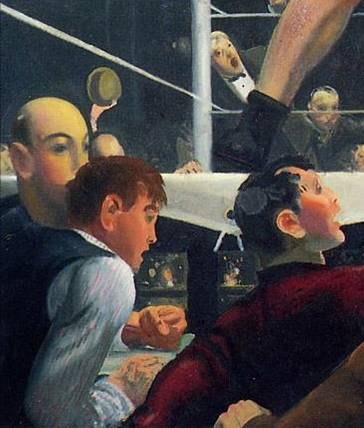
Inside and Outside, or a Spectator Gets into
the Action
Bellows painted himself here as the spectator all
the way to the left. His face looks, calm, unperturbed, impassive. But
is that his fist on the table below? If so, in the painting he presents
himself as both active and passive, while in his life there was a fight
about these opposites, as there was in me.
Bellows was a socialist
and numbered among his friends some of the most important persons of the
left—Emma Goldman, John Reed and labor leader Big Bill Haywood—-people
who were willing to go to jail for what they believed in—-people who fought
for justice. Although Bellows was a social critic in many of his
paintings, in his life he had a conflict, I believe, as to how much he
would put himself on the line as others did. To make money, to care
for his family, he did portraits of the rich, but his heart wasn't in it.
It was a fight and it went on throughout his life-—a life tragically ended
at the age of 43. Bellows died of appendicitis seven months after
completing this painting. I believe in this canvas he was giving
form to that fight he never resolved in his life. He may have wondered
as I did: "Is there anything worth fighting for?" I wish he could
have heard what I did when in an Aesthetic Realism class, Eli Siegel explained
to me: "There's a distinction to being a spectator — that is other people
worry but we look on -— two people are scratching each other, but there
ain't no blood on my hands."

In this painting, Bellows puts us right in the
midst--second row ringside, and then he leads us up the body of Dempsey
to Firpo squarely in the ring. Dempsey has one leg still within the
ring but is flying out. The referee, as he holds the ropes, delineating
the outside of the ring from the inside, has his hand on the outside of
the rope and his straight arm counting is inside.
Bellows also joins inside
and outside through color. The purple color (above) of Firpo's trunks
is repeated in the jacket of the spectator below. The light trunks and
paler body of Dempsey outside the ring are related to the referee in his
white shirt and cream-colored trousers inside. The oppo- sites in man are
in the arena in which his strugglestake place, in the diagonal and horizontal
ring ropes which tie the painting together.
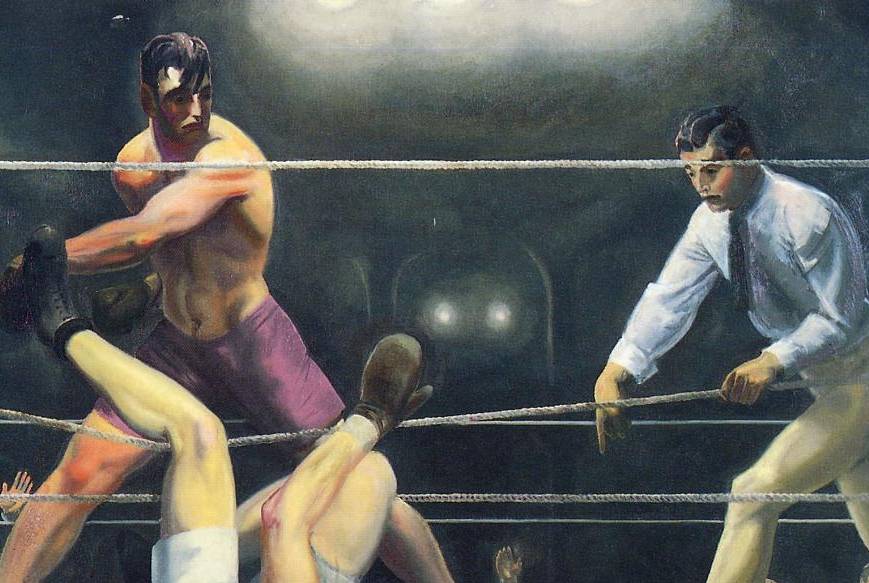 The top rope, which goes from edge to edge on the
canvas, horizontally crosses the referee and Firpo. It goes across the
forehead of the referee and crosses over the powerful shoulder of the fighter—the
same shoulder which provided the force of the punch that sent Dempsey through
the ropes. Action and thought are joined in a straight line.
This is a decisive action, "no wearisome" indecision or the feeling of
a "tired worm on a hot day, dragging itself across Fifth Avenue."
The top rope, which goes from edge to edge on the
canvas, horizontally crosses the referee and Firpo. It goes across the
forehead of the referee and crosses over the powerful shoulder of the fighter—the
same shoulder which provided the force of the punch that sent Dempsey through
the ropes. Action and thought are joined in a straight line.
This is a decisive action, "no wearisome" indecision or the feeling of
a "tired worm on a hot day, dragging itself across Fifth Avenue."
Opposition and Agreement for the Same Purpose
For a painting to be beautiful, I learned, opposites
must be one. Bellows shows both agreement and disagreement through
form. The two fighters are portrayed at their utmost opposition.
One is up, one is down. One has great stability—-Firpo's stance makes
him look almost as stable as one of the pyramids and Dempsey is sprawling
with arms and legs going this way and that. But through form, Bellows
makes these two opponents work together, and the result is we feel we are
in a world that is exciting and orderly at once, a world that makes sense.
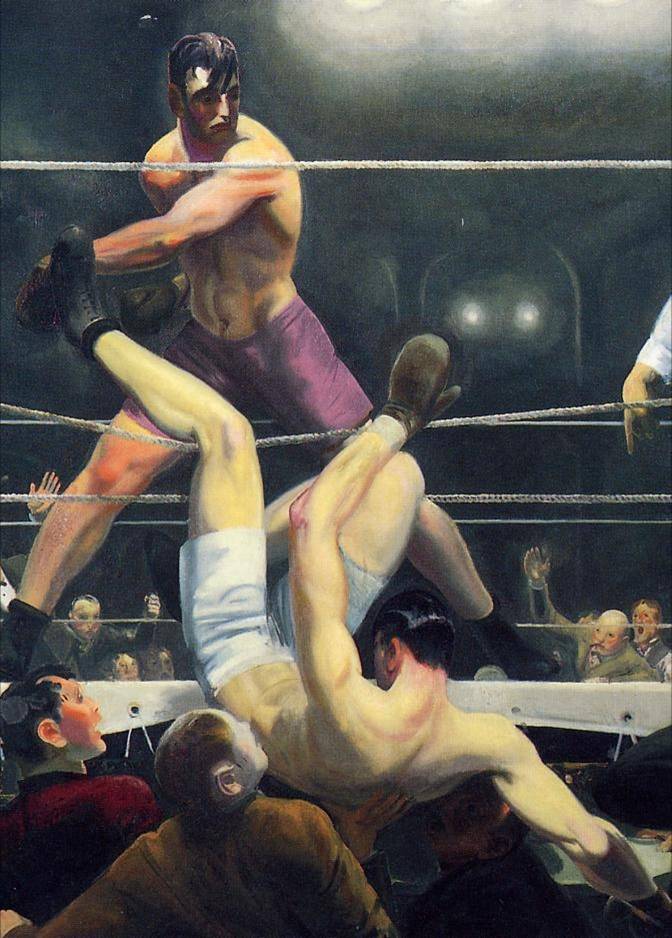
See how, for instance, the fighters left legs run
parallel to each other. The same is true of their left arms—- Firpo, following
through on his punch, and Dempsey raising his left arm for help as he falls.
Dempsey's right arm completes the strong diagonal line of Firpo's left
leg. And see how Firpo's left arm, following through on its punch, makes
a dramatic angle with Dempsey's left leg.
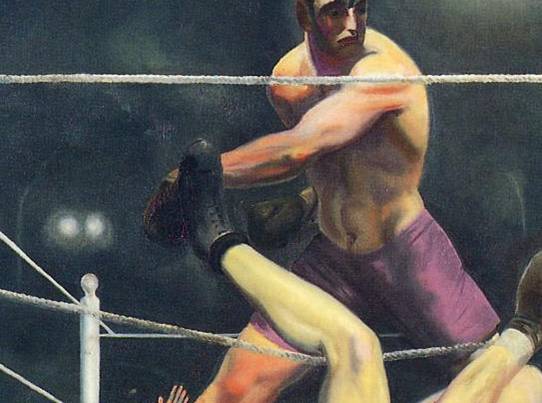
The dark glove of Firpo and the black shoe of Dempsey
meet in space and the forms merge in a way that is gentle, surprisingly
friendly. I think Bellows felt friendliness and opposition as one thing
as he did this painting.
In an account of this
two-round fight, ultimately won by Dempsey,--he climbed back in the ring
and won by a knockout in the next round-- Paul Gallico wrote:
From the opening bell, the.
entire crowd, got to its feet and remained standing for the balance of
the fight... the greatest sustained mass audience hysteria ever witnessed
in any modern arena.
Bellows takes the highlight of this frenzy and gives
it structure; shows the permanent structure of the world is there even
at the peak of intensity.
High and Low, Up and Down
In an issue of The
Right of Aesthetic Realism to Be Known. titled "Contempt Hurts
Mind," Eli Siegel described the ugliest thing in self in relation to a
prizefight, and as he did, he was fighting beautifully against the greatest
weakener of mind. He wrote:
When a human being rebels
against anything, there is anger in him; but he would like very much to
change the anger into contempt. It is like a prizefighter summoning
up his combative strength to defeat an opponent; but should he find the
opponent lying on the floor with the referee counting over him, the prizefighter's
purpose has been successful: he can now have the repose of contempt.
All anger would like to become contempt. Anger has pain in it, but
contempt is inward bliss/; repose; some quietude.
I wanted that "inward bliss" of contempt. I could
imagine myself a 265-pound football guard, throwing blocks at people I
didn't like on the street. This ugly way I had of elevating myself
was followed by a painful meekness and nervousness around people.
I learned from Aesthetic Realism—the false way we make ourselves high is
the reason we feel so low.

One of the things most beautiful in Bellows' painting
is the way the opposites of high and low work together. Our eye is
brought up and down from one fighter to the other. We go from the
top of Firpo's head, down Dempsey's leg, around the curve of his back to
the bottom where Dempsey's right arm disappears off the canvas at the
lower right. Then we go back up his arm,
across Dempsey's shoulders, up the curve of his raised arm, and up the
leg and side of Firpo to Firpo's head again. There is a constant rhythm.
The referee's gaze, like Firpo's goes from up to down. In the crowd,
figures lean forward and back, repeating up and down motion. Their
positions are low in the canvas, but they gaze upward. We are seeing Dempsey
at the moment of his greatest humiliation, but we cannot feel contempt
because, for one thing, his head is going up again — so is one foot on
the left, one arm towards the right. He is down and up; he is not
beaten.
Toughness and Gentleness
Before studying Aesthetic Realism I thought strength
and kindness had to fight. Bellows paints these strong, powerful
men with brush strokes both smooth and bold.
This fight shocked the
sporting world as Dempsey, the overwhelming favorite, was knocked out of
the ring. Bellows, at ringside, was covering the fight as a newspaper
illustrator. He -is quoted as saying: "When Dempsey was knocked through
the ropes he fell in my lap.” And, jestingly, he said, “ I cursed
him a bit and placed him carefully back in the ring with instructions to
be of good cheer."
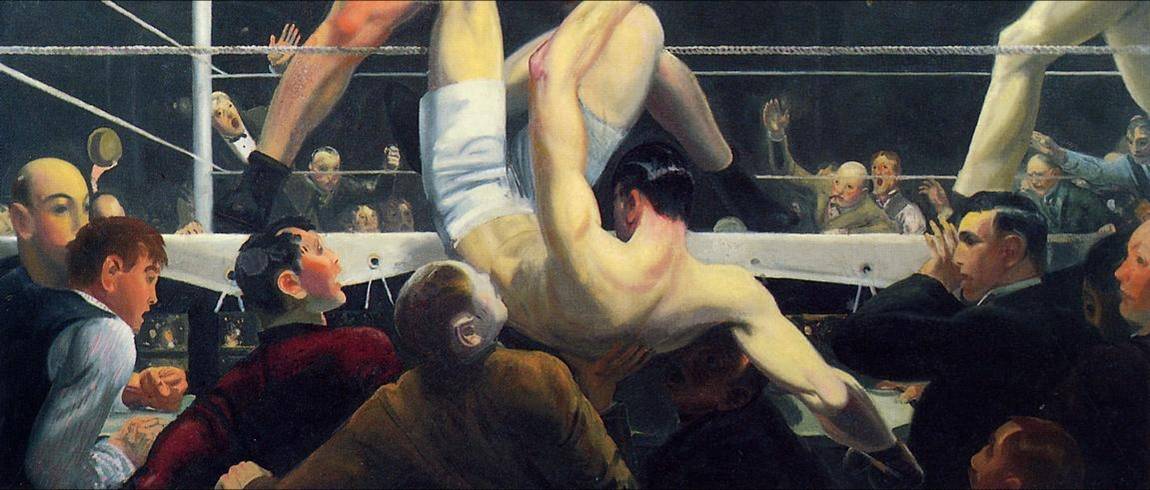
It’s an affecting part of the work that as we see
man as brutal through a punch we also see man as helpful through the open
hand of a ringsider who cradles Dempsey's fall and gives it an upward spring.
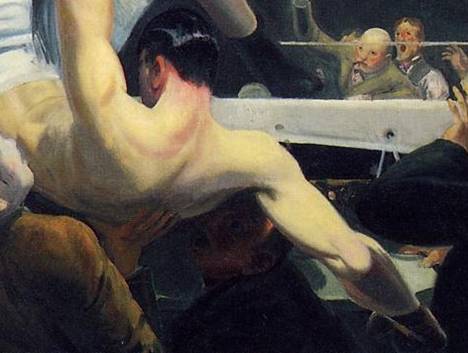
There’s a counterpoint of fists and open hands
throughout the canvas. This painting is not just straight reporting,
it is also criticism, ethics. I learned that all good criticism,
which we all need, is a oneness of punch and houghtfulness for the
purpose of having us stronger than ever. When I saw the beautiful oneness
of strength and kindness in Aesthetic Realism I felt I was placed in the
world for the first time It made me feel I wanted to be in life, part of
life, in the midst, not off to the side. I learned about the biggest
fight in myself when Eli Siege1 said to me in a class:
We
think evil is the biggest thing, and if the world is bad, that much we
are elevated.
And he asked me:
Are you ready, now to see
consciously the fight between good and evil, and see which you really want
to give your devotion to? It's the biggest fight in the world.
Let truth and falsehood battle it out, but in a fair fight, who would ever
see truth lose? The fight between good and evil should be on the Stadium
stage.
Mr. Siegel taught me that what makes a fight beautiful
is its purpose and I love him for it. A beautiful fight is in behalf
of the beauty and truth of this world.
Home | My
bio |
Links | Email
|
Sitemap
|